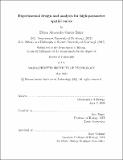Experimental design and analysis for high-parameter spatial omics
Author(s)
Baker, Ethan Alexander García
DownloadThesis PDF (73.80Mb)
Advisor
Regev, Aviv
Terms of use
Metadata
Show full item recordAbstract
Recent decades have witnessed the dawn of an era of molecular biology as a data science. Technological advancements have enabled high-parameter molecular measurements (“omics”) to progress from bulk data, averaged across entire tissues or organisms, to single-cell measurements, which enable exploration of the vast diversity between individual cells, to a new frontier, spatial omics, which enables rich molecular measurements of single cells in their native tissue context. Spatial omics methods complement the rich history of histopathology to unlock new avenues to explore the spatial components of tissue biology. However, high-parameter spatial omics data present unique statistical and computational challenges, and substantial work is required to ensure that findings of spatial omics experiments are actionable in the laboratory and clinic. Here, I examine the underlying statistical properties of spatial biology to propose a general framework for experimental design in spatial omics, introduce an approximate generative model of tissue structure, and demonstrate methods for semantic segmentation and community detection in spatial omics. Finally, I share an outlook on how, when considered jointly, these contributions represent first steps towards optimal experimental design for spatial omics.
Date issued
2022-05Department
Massachusetts Institute of Technology. Department of BiologyPublisher
Massachusetts Institute of Technology